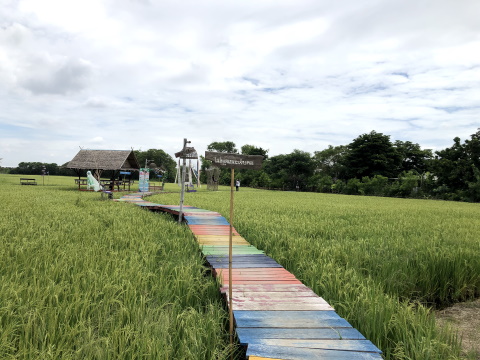| Back to Back Issues Page |
 |
|
Bangkok Travelbug Sep 2020 Thung Na Mon Bo Thong – the Mon Farm September 16, 2020 |
| Hello
The history of the Mon dates back several centuries, the first kingdom was established in Thaton, 110 km east of Yangon, Burma in the 9th C. Thaton was sacked by the Burmese 1057. In 1287 the Mon established the Hanthawaddy Kingdom in the lower Irrawaddy with their capital in Pegu (present-day Bago) 65 km northeast of Yangon. Pegu was captured by the Burmese in 1539 and Martaban (Moke Tha Ma) in 1541. The Hanthawaddy Kingdom was re-established in Pegu in 1740 only to be sacked again in 1757. This time the Mon Kingdom was completely crushed. The Mon were dispersed, many fled to Siam during the Ayutthaya period. During the Burmese-Siamese Wars, Mons fought alongside the Siamese against the Burmese. After the war, they were granted land to settle in various areas in and around Bangkok. Many of them settled along the west bank of the Chao Phraya in Pathum Thani about 40 km north of Bangkok and built several temples in an area known as Sam Khok. Being skilful potters, they built three earthen kilns to heat their pots and jars. These kilns looked like huge moulds of earth and gave the place its name Sam Khok (sam – three, khok – moulds) . Others chose to settle further to the west of the Chao Phraya in an area called Lat Lum Kaeo which is where Thung Na Mon is located and that's where we are heading. 
Thung Na Mon Contents About the farm Thung Na Mon in Ban Bo Thong is not merely a rice field of the Mon community, as the name suggests. It's a complete farm with a huge rice field, vegetable plots, orchards and green houses, chicken and duck rearing. 
Chart showing the layout of the farm The entrance is at the bottom right and the bridge leads to Thung Na Mon 1 - food centre. 2 – seating area for the food centre overlooking a pond. 7 – chicken and duck farm. 9 – greenhouse for melons. 10 – resting areas by the cultivated plots 11 – cultivated plots separated by ditches. 17 – sala (pavilions) by the rice field & rice field The rest rooms and exit are at the bottom left of the chart Thung Na Mon which was built in 2018 serves as a demonstration farm and knowledge centre to support the farming efforts of the Mon community as they promote and preserve their way of life, culture and food. The project also gives residents a chance to sell their farm products to augment their incomes. This six rai of land (approx. 9,600 sq. m or 11,481.5 sq. yd) was granted by the abbot of Wat Thian to Thanjira Ongartudomrat and her community in Ban Bo Thong to use for this purpose. A signboard at the far edge of the rice field records the gratitude of this community to the abbot. 
Signboard thanking the abbot Contents Tour of the farm 
Entrance to Thung Na Mon After going through the entrance, we crossed a bridge which took us to Thung Na Mon. Give the food centre and stores selling local products to the left a miss for the time being and turn right. 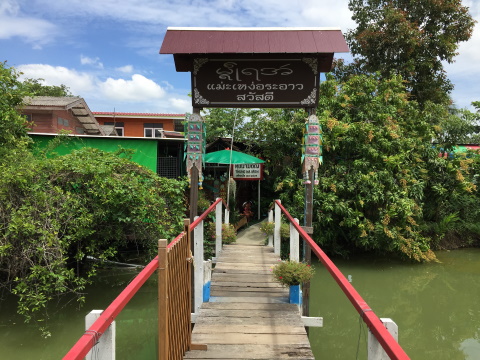
Bridge crossing over to Thung Na Mon We came to a fork with a café in the centre. 
Start your walk with a coffee? After your coffee, take the left fork to visit the chicken and duck farm. 
Chicken and duck farm What aroused our curiosity was a Ferris wheel with chicken coops in place of the seats. There's a chicken in each coop with food and water provided. The wheel is rotated very slowly by the gentle breeze. 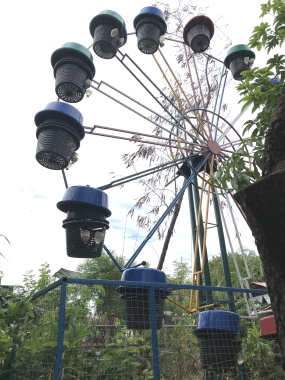

Chickens on a Ferris wheel with food and water provided Later when we were at the food centre, we asked one of the vendors the reason for this practice. According to her, the chickens are more relaxed when kept this way and become more productive in laying eggs. Walk down a narrow tree-lined path that leads through the orchard. 
Path through the orchard – note the low hanging mango At the orchard there are bananas, mangoes, pomelos and melons; some of the fruits are hanging overhead and some are almost touching the ground. 
Low hanging mangoes There is a greenhouse where melons are grown. 

Melons in a greenhouse The cultivated plots are separated by irrigation ditches, the farmer rows his boat along the ditch between two plots and uses a bucket to water his plants, a cheap and effective method. 
Plots separated by ditches There's an observation tower at the end of the path through the vegetable garden and orchard. If you are energetic enough, climb up to the top for a good view of the entire area. 
An observation tower for a bird's eye view of the farm From this point, turn into the rice field and walk through over a raised wooden walkway. The beautiful golden ears of rice ripening are just marvellous to view. Lots of opportunities for photographs here. 
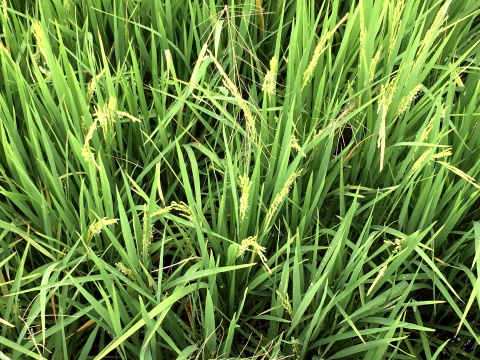
Golden ears of rice The boardwalk circuit took us through the rice field and past the Wat Bo Thong School where children were having their Saturday morning lessons just next to the rice field. It's not often that we can get a chance to walk through a rice field like this. 

Walking through the rice field At one end of the rice field there is a row of sala (pavilions) for visitors to sit and relax or have a picnic. 
Sala by rice field for rest or picnic We finished the circuit to come round a corner and ran into a permanent resident of Thung Na Mon standing under a tree. 
A scarecrow that's a little to real It is apparent that lots of effort has been put into making the whole place comfortable and enjoyable to visitors of all ages. 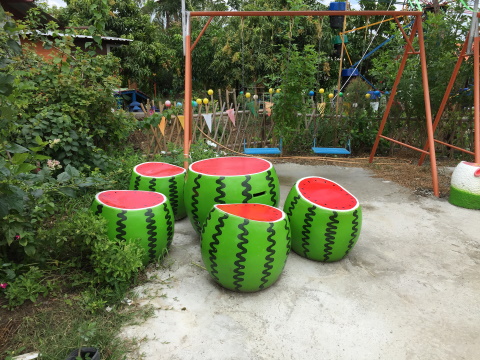
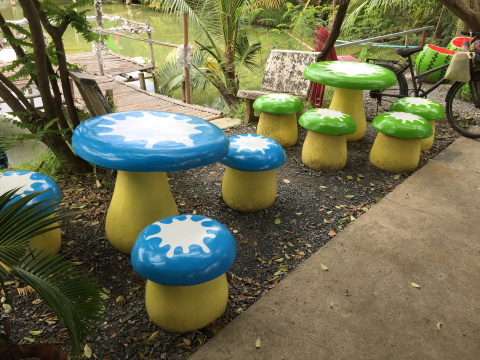
Colourful tables and chairs made to look like water melons and mushrooms Take a breather under the pomelo trees with fruits hanging overhead. 
Pomelos overhead After that refreshing walk through the rice field, we came to a section selling snacks and other delicacies. Khao kriab is made from grinding sticky rice mixed with water to a fine paste, this is spread out in a thin batter which is deep fried in oil. The result is a crispy cracker that's about the size of a pizza. 
Khao kriab – a rice cracker It's very brittle, careful how you carry it around or it'll break into pieces which are just as delicious. 
Khao kriab – all broken up Kalamae, another Thai sweet delicacy is made from heating sticky rice with coconut milk and sugar from coconut flowers. The mixture is stirred in a huge pot over a strong fire until it turns thick, black and gluey. The mixture is cooled and then cut into strips. It's extremely sweet snack, those with a sweet tooth will love it. 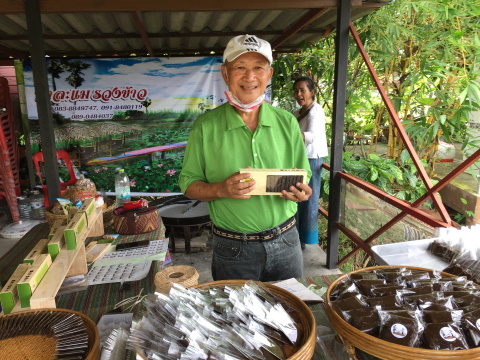
Lung (uncle) displaying his products 
The ingredients 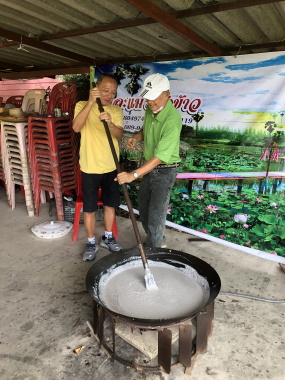
Lung letting me try my hand at stirring the mixture 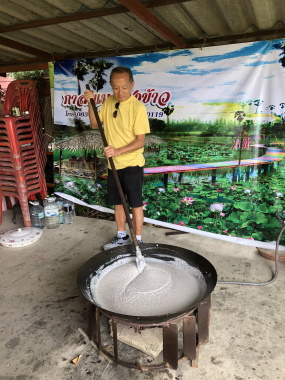
Imagine standing here for five to six hours doing this After a long loop around the farm, we end up in the food centre and the stores selling the local products and fruits. Various fruits and snacks are placed here by the members of the community to be sold. 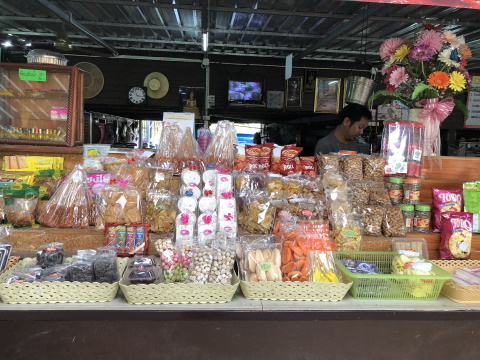
Local products on sale 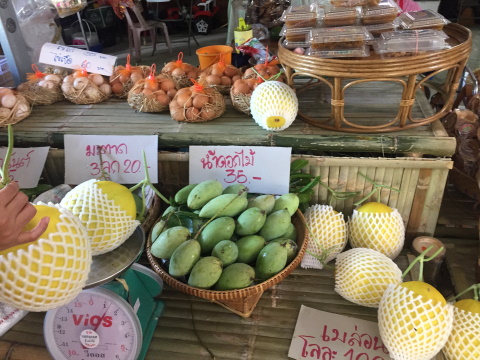
Cantaloupes and mangoes fresh from the orchard 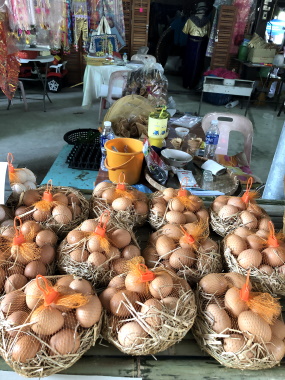
Farm eggs We came across a lady in traditional Mon dress preparing another very special Thai dessert, kanom bueang Mon. This is different from the kanom bueang Thai which is flour batter heated over a hot pan and filled with shredded egg or shrimps. Kanom bueang Mon is made with egg batter heated over a pan and filled with shredded shrimps, bean sprouts, onions, garlic, ginger and celery. It's also larger. The batter is then folded over the fillings, like an omellette. 
Kanom bueang Mon heated over a hot pan 
The ingredients It was only much later that I realized that this lady was none other than Thanjira Ongartudomrat in person. What a pity, I didn't take a photo of her. The highlight of the visit was lunch in the food centre overlooking the fish pond. You can choose to sit at the low tables or at glass tables at the edge of the pond and daggle your feet over the water. 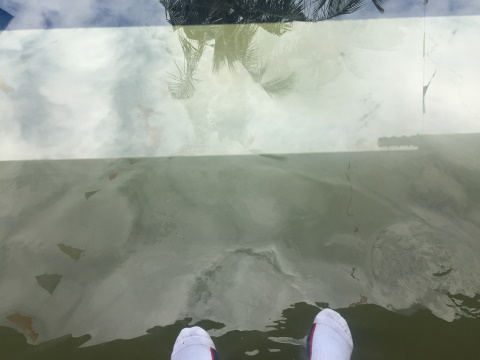

Let your feet hang over the side while you eat I had a scrumptious meal of pad thai and chocolate ice cream for dessert, a fitting end to an enjoyable Saturday outing. Contents Our Thanks Our thanks to the members of the Mon community for explaining to us how their food and snacks are being prepared and also their farming methods. We wish their community all the best in their efforts to preserve their culture and farming methods. Contents Map to Thung Na Mon If the map doesn’t appear, click on this link How to get to there From Bangkok take highway 9 (Kanchanaphisek Road) and head north till you get to Pathum Thani. Turn left into route 346, once you find Soi Khu Khwang 5 on the opposite side of the road, make a U-turn and turn into Soi Khu Khwang 5. Keep going till you pass Wat Bo Thong and the Wat Bo Thong School and you will get to Thung Na Mon. Contents Next month Exploring old markets in Pathum Thani. Khlong Sip Song 100-year old Market, Lam Luk Ka, Pathum Thani If you enjoyed reading this e-zine, please forward it to a friend. If you received this from a friend and found it interesting, please subscribe at Bangkok Travelbug. What do you think of the Bangkok Travelbug? We love to hear from you What other subscribers have said Till next month then. Eric Lim Tour Bangkok Legacies Find us on Facebook My Journey through Thailand Part I The First Steps This is my second e-book and the first in the series of travel journals on my trips to explore the various provinces in Thailand. This edition, which covers my travels from late 2009 to mid-2013, will guide you to historical sites, cultural monuments and exquisite Thai handicraft, across a vast spectrum of cultural and ethnic diversity. You can have a virtual tour with this e-guide book or take the first steps yourself in this journey through Thailand. My Kindle e-book 
Copyright@2008-2020 Tour Bangkok Legacies All rights reserved |
| Back to Back Issues Page |
